Industrial Hemp Production and Management
- Varieties
- Seeding
- Field Selection
- Fertility
- Weed Control
- Insect Control
- Disease Control
- Organic Hemp Production
- Weather Damage
- Harvesting
- Grain Harvest
- Fibre Production
- Yield Expectations
- Risk Management
Varieties
There are a number of industrial hemp varieties that producers can choose from. Some of the attributes that distinguish the varieties are height, maturity, seed size, oil content, oil composition and fibre content. The target end use will determine which attributes are more favourable and which variety has the best potential for that end use. Varieties destined for the fibre market may contain 15% to 25% bast fibres, whereas varieties for the grain food market will have desirable oil profiles and content. As markets continue to develop and varietyal descriptions expand, contracts for a specific end use may specify which variety to grow to meet the market requirements.
Growers must use pedigreed seed of a variety approved by Health Canada. An annual list of approved cultivars is updated each year and is available from Health Canada or your seed retailer. It is illegal to use non-certified or "common seed". A list of varieties along with growers and distributors of certified seed can be found in the annual Seed Manitoba Guide. The guide is available at your local GO Team Centre/Office or on the internet. Supplementary agronomic data is also available in the Manitoba Diversification Centres annual reports. Detailed records must be kept of all seed purchases.
Industrial hemp varieties registered in Canada must contain less than 0.3% THC. Health Canada’s guideline for THC testing requires sampling to be conducted when the first fruits of 50% of the plants show resistance to compression. The THC level may vary with growth stage and environmental conditions. Because of this, it is important to follow the Health Canada guideline to ensure accuracy of the test results and minimize the probability of retesting.
Height is an important attribute in determining the end use of the crop. Shorter varieties tend to have less fibre and are more suited for grain production. Most of the taller varieties are considered “dual purpose” because they produce good grain yield, plus have the desirable volume of “bast” fibre for fibre production. Heights can range from 1 to 1.9 meters. Hemp plants will mature for fibre production in 60-90 days and for grain in 90-120 days.
Seeding
The purpose of production will dictate seeding rates. Fibre production or “dual purpose” production recommends a target plant density of 250 – 300 plants/m2 (23 to 28 plants/ft2), whereas grain production recommends a target plant density of 100 – 125 plants/m2 (10 to 12 plants/ft2). This translates into 40 to 50 pounds per acre and 18 to 23 pounds per acre, respectively. Hemp’s bushel weight is 44 pounds.
Other factors to consider when calculating seeding rates are 1000 kernel weight (TKW) and seedling mortality rate. 1000 kernel weights are variety dependent and can be affected by environmental conditions. 1000 kernel weights can vary from 13.5 grams to 21.5 grams for the varieties currently grown in Manitoba. Taking the variation in seed size into consideration when calculating seeding rates is very important in ensuring target plant stands are met. Meeting target plant stands contributes to weed competitiveness and control, efficient use of nutrients, ensuring optimal seed size for food end-use markets or pedigreed seed production and achieving desired fibre stem size for fibre production.
The industry has observed that seed mortality can range anywhere from 10% to as high as 70% and it needs to be considered when calculating seeding rates. More research is required to develop a better understanding of seed mortality and the factors influencing it so that sound recommendations can be made. Some of the factors that could be affecting seed mortality are air seeder wind speed cracking the seed coat, previous damage to the seed coat from harvest and drying conditions and environmental conditions at time of seeding that may give rise to higher levels of soil pathogens. Currently 30% mortality rate is used when calculating seeding rates. Table 1 below outlines the varieties, their corresponding 1000 kernel weight and calculated seeding rates assuming a target 10 seeds/ft2, 95% germination, 30% mortality rate and using the average 1000 kernel weight for each corresponding variety. Alberta Agriculture offers an interactive seeding rate calculator on their website.
Table 1. 2012 Industrial Hemp Grain Variety Trial 1000 Kernel Weight for 2011-2012 Variety Trails - MB. Diversification Centers.
Variety |
Average 1000 Kernel Weight (g) |
Site Years |
Minimum 1000 Kernel Weight (g) |
Maximum 1000 Kernel Weight (g) |
Seeding Rate* (lbs/acre) |
|---|---|---|---|---|---|
Alyssa |
18.1 |
7 |
15.7 |
19.0 |
26.1 |
Anka |
16.2 |
7 |
13.5 |
17.5 |
23.4 |
Canda |
19.5 |
8 |
14.8 |
21.5 |
28.2 |
CanMa |
16.3 |
2 |
15.5 |
17.0 |
23.5 |
CFX-1 |
16.9 |
8 |
14.1 |
18.5 |
24.4 |
CFX-2 |
15.9 |
8 |
14.6 |
17.0 |
23.0 |
CRS-1 |
17.3 |
8 |
15.6 |
19.0 |
25.0 |
Debbie |
18.0 |
3 |
16.4 |
19.5 |
26.0 |
Delores |
18.2 |
7 |
14.5 |
20.0 |
26.3 |
Finola |
13.1 |
8 |
11.0 |
14.6 |
18.9 |
Joey |
18.3 |
5 |
15.3 |
19.6 |
26.4 |
Jutta |
18.4 |
3 |
17.4 |
19.8 |
26.6 |
Petera |
20.0 |
1 |
20.0 |
20.0 |
28.9 |
Selesia |
15.5 |
4 |
14.2 |
17.0 |
22.4 |
USO14 |
17.0 |
4 |
15.0 |
18.0 |
24.5 |
X59 |
17.2 |
4 |
13.5 |
21.0 |
24.8 |
Assumptions: 10 seeds/ft2, 95% germination, 30% mortality and using the average 1000 kernel weight for each variety
Source: Parkland Crop Diversification Foundation (PCDF) annual report (2012)
Field Selection
Hemp grows well on a range of soil types. It is intolerant to poor soil drainage, salinity and excessive, wet growing conditions. Saturated soils will quickly cause stunting, yellowing and death of plants especially early in the season.
Seeding Depth
Shallow seeding, soil temperatures of 8 to 10 degrees or higher and good soil moisture will facilitate uniform and fast emergence. A seeding depth of 0.5 to 1 inch is recommended. Plant vigor increases during the development of the plant so it is important to seed into favorable conditions for optimal plant establishment. Increasing the seeding depth can result in poorer stands which will negatively impact weed competition and fibre quality of the straw. Plant stands and establishment have been lost due to deep seeding coupled with cold wet soils.
Seeding Date
Seeding date is not as critical as achieving optimal seeding conditions. Previous research and grower experience has shown that hemp can be seeded as late as mid-June and still achieve reasonable grain yield. Hemp seedlings are tolerant to light spring frosts and a hard fall frost will facilitate maturation and leaf desiccation. One thing to note is volunteer hemp will be the first plants to emerge the following spring. Hemp plants have a dual response to day length. Increasing day length during the early stages of development will promote vigorous vegetative growth and shorter day length in August will trigger flowering and maturation. Flowering generally occurs at the same time every year. Therefore, early seeding will promote taller plants and more vegetative growth and it will have no effect on date of harvest. Environmental factors will have a bigger effect on harvest date.
Seeding Equipment
Precision in seeding is important for establishing target plant density which will create efficiencies in input usage and the overall financial return for the farm business. Hemp can be seeded with conventional seeding equipment such as air seeders/drills, hoe-press drills and disk-pressed drills. Air delivery systems need to be used with caution. Seeds can be cracked in the manifold if the air flow is too high. It is recommended that a low volume of air be used that allows seed delivery without causing the hoses to plug. For most soil types, hemp will benefit from press wheels or packing after seeding to ensure good soil to seed contact. All seeding equipment must be cleaned after the seeding operation is completed.
Fertility
More research is required to develop a better understanding of hemp fertility requirements. Currently the rule of thumb for fertility recommendations is to treat hemp production similar to a high yielding and high protein spring wheat production.
Soil testing is highly recommended to determine existing nutrient levels in the soil prior to fertilizer applications. The soil test will give recommendations for additional nutrient requirements to achieve target yields. If soil analysis is not an option, a general recommendation is to have the following amounts of available actual nutrients: 89 to 135 kg/ha nitrogen, 45 kg/ha phosphorus, 67 kg/ha potassium and 17 kg/ha sulfur.
The other component to fertility management is to understand the rate of nutrient removal a crop will undergo during its development. It is also important to understand where the nutrients are ending up in the plant physiology and if some of the nutrients will return to the soil for next year’s production. Table 2 outlines the uptake and removal rates of hemp compared to canola. For nitrogen, hemp removes a total of 200 kg/ha, 40 kg/ha of which is stored in the seed and 160 kg/ha in the stalk. If the hemp is grown for both grain and fibre production, there will be a large amount of nitrogen removed from the field and growers need to be cognizant of nitrogen requirements for the next production year. For potassium, the retting process of the straw causes the potassium to be leached out and it accumulates in the soil under the swaths. Of all the nutrients mentioned, phosphorus has the highest percentage being stored in the seed. The other nutrients are more inclined to be stored in the stalks.
There are a number of factors that affect nutrient uptake and removal. Some of the factors include environmental and growing conditions, soil pH, salinity, excess soil moisture and soil compaction restricting the aerobic ability of the soil, crop type and varietal differences.
Depending on the variety, hemp will grow 7 to 10 cm a day during its vegetative stage in July to early August. During this development stage, the maximum rate of nitrogen uptake is about 6.7 kg N/ha/day. Phosphorus uptake is about 1.56 kg P2O5/ha/day.
Hemp seed appears to be sensitive to seed-placed nitrogen fertilizer. It is recommended that the nitrogen be side-banded, mid-row-banded or banded in a separate operation.
There has been some research conducted on phosphate fertility trials in hemp. The trials indicate a reasonable tolerance to seed placed phosphate. Under ideal growing conditions plant population and grain yield was not affected by increasing the rates of P2O5. At the suggested rate of 34 to 45 kilograms/hectare and good growing conditions, damage is not expected to hemp seedlings. Sensitivity could be evident if germination is delayed due to less than ideal conditions such as cool soils, drought or wet compacted soils. More research is required to understand phosphate placement and hemp production.
Additional fertility research results conducted by the Parkland Crop Diversification Foundation can be found in their annual report. Other fertility information can be found in the Manitoba Soil Fertility Guide.
| Table 2: Nutrient Uptake and Removal of Field Crops (kg/ha) | |||||
| Total Plant (kg/ha) | Grain (kg/ha) | Uptake | |||
| Nutrient | Hemp | Canola |
Hemp |
Canola |
Hemp/day |
N |
200 |
120 |
40 |
65 |
6.7 |
P |
47 |
50 |
19 |
35 |
1.56 |
K |
211 |
75 |
10 |
17 |
6 |
S |
14 |
20 |
3 |
12 |
|
| Source 1: Canadian Fertilizer Institute | |||||
Weed Control
There are no in-crop herbicides registered for use on industrial hemp in Manitoba. Pre-seed burn-off with glyphosate is the only option for conventional growers. Hemp is very competitive with weeds as it develops in height and plant density. Following seeding recommendations coupled with pre-seed herbicide burn-off or pre-seed tillage would allow hemp plants to become established before most weeds emerge and it would optimize its competitive advantages.
Wild buckwheat and volunteer barley seeds are difficult to clean out of hemp grain. Avoid growing hemp in fields where these weed problems might exist. Volunteer barley or other cereals also present a marketing issue. Hemp is promoted as being gluten free so it is important to avoid the possibility of contamination.
Unregistered use of herbicides is not recommended. Proper herbicide testing and registration on crop types ensures food safety. Many of the contracts with food processors specify no herbicide use and unauthorized herbicide usage could result in unfavorable marketing options for producers. It could also jeopardize the integrity of the product and future market access.
Volunteer Hemp Control
Hemp regulations require that all volunteer plants be eliminated in the field/crop following hemp production. There are no herbicides that specify volunteer hemp on their label but there are a few options available. Phenoxy herbicides such as 2,4-D can be used independently or in a tankmix with glyphosate as a pre-seed application. Paraquat (Gramoxone) is another option as a pre-seed burn-off. One thing to keep in mind is re-cropping restrictions for the pre-seed applications of these products, especially 2,4-D.
Crop rotation and herbicide selection are important management strategies for controlling volunteer hemp. Choose crops that have the appropriate herbicide chemistries available to control various staged volunteer hemp. Crops such as fababeans and Liberty Link canola are not good options. Fababeans have minimal broadleaf herbicide options and Liberty herbicide is only effective on small hemp plants. Cereals would be the best option for following hemp production because of the multitude of herbicide options and non-common diseases. Glyphosate resistant canola would be a good option as well, but be mindful that hemp can have low levels of sclerotinia.
Insect Control
Bertha Armyworm (Mamestra configurata) may be a significant pest to industrial hemp. Bertha armyworm is a cyclical pest in canola and other crops in Manitoba. In 1995 bertha armyworm caused significant defoliation in some hemp production areas and there was some limited damage in 2011.
Cutworms are generally a spring pest and they can occur in hemp production. Spring scouting is recommended and groupings of dead plants or bare patches in the field are evident of cutworm activity.
Grasshoppers can be a pest and the probability is higher when production occurs near pasture or hay land. Grasshoppers can move into the field in the spring if conditions are favorable for an early hatch. Late season infestations can result in damaged seed heads and possibly reduced production. Economic thresholds are unknown at this time.
Lygus Plant Bugs have been found in high numbers in hemp but damage and economic thresholds are unknown.
European Corn Borer have occasionally been found in hemp stands. No economic numbers or thresholds have been documented. The Corn Borer can weaken the stem and result in stalk breakage at the point of entry.
For more information on these insects, and on "Scouting for Insect Pests" go to the MAFRD website.
Disease Control
Sclerotinia stem rot has been found in hemp fields in most years. The level of damage and yield loss is yet to be determined. Sclerotinia sclerotiorum and Botrytis cinerea can be found in the stalk portion of the plant similar to canola. Later infections have been observed in the head of the hemp plant which has resulted in grain loss.
Wild mustard and volunteer canola, or adjacent canola stands can be the source of Sclerotinia stem rot infections. Adequate rotation with non-susceptible crops, ensuring seed free of disease organisms, and management of host species are the key approaches to manage disease risk.
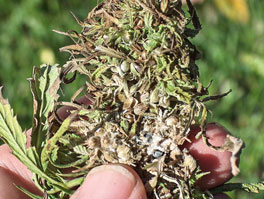 Sclerotia in Head |
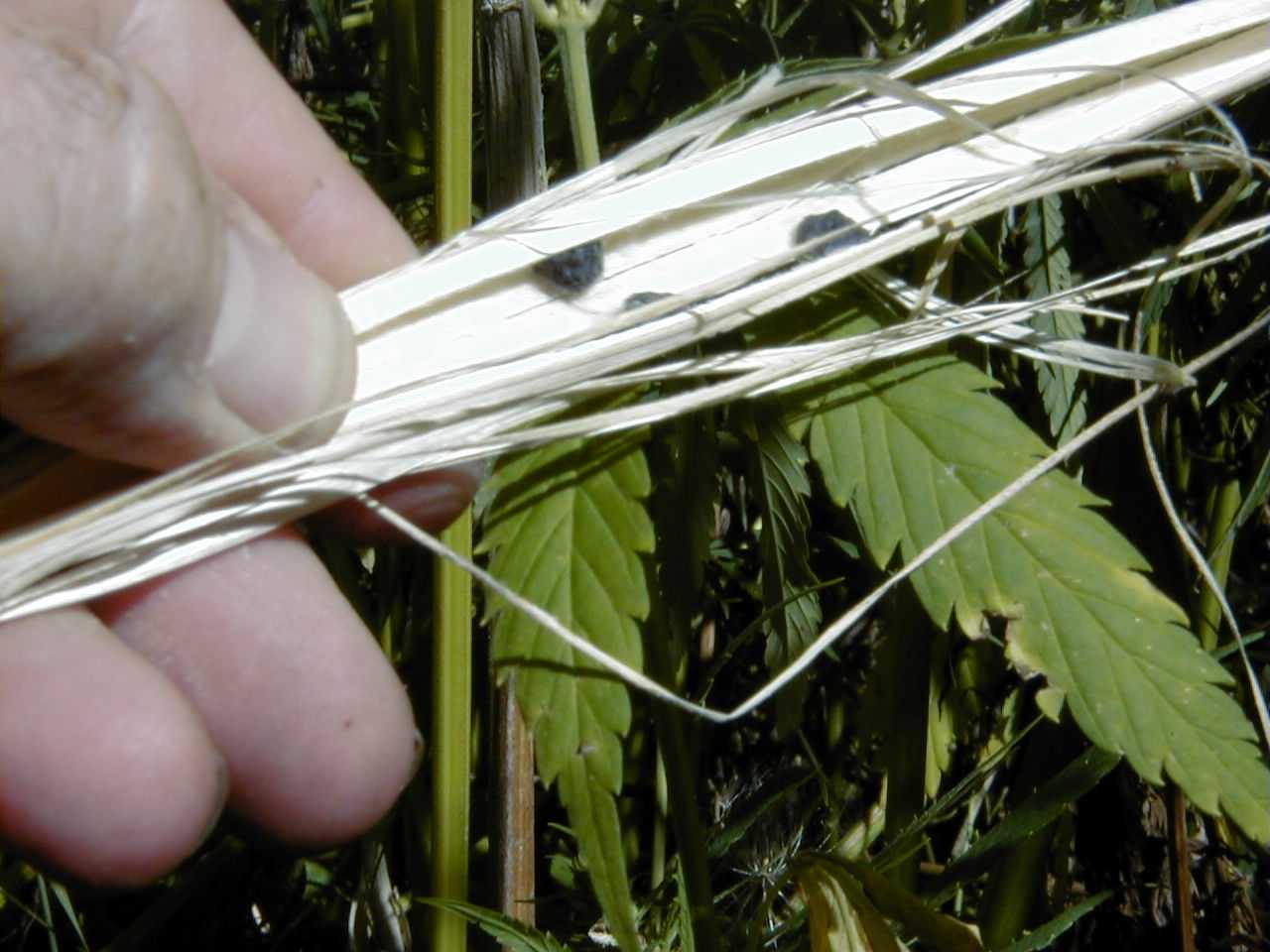 Sclerotia in Stem |
For more information on these Diseases and other references like “Scouting for Diseases” go to the MAFRD website Scouting for Diseases or information on other potential diseases go to the Plant Disease Menu.
Organic Hemp Production
Organic hemp production offers another marketing opportunity for producers. Fertility management under an organic production system is one of the best options for good weed control. Organic hemp production will be most productive in the following scenarios: following a perennial legume such as alfalfa, summerfallow, fields with previous animal manure applications or composted manure and green manure rotations. Refer to and be familiar with the certification requirements of organizations like Organic Producers Association of Manitoba Co-operative Inc.- OPAM
Most industrial hemp processors have specific organic grain markets. A price premium of 50 to 60% is generally paid to producers and securing a contract prior to production is highly recommended. Currently market demand exceeds production.
Weather Damage
Excess Moisture
Excessive rainfall and saturated soil conditions that persist for several days are very detrimental for hemp development especially in the early stages. Hemp plants turn yellow and cease development (photo). The most severely affected die. This is more prevalent in low lying areas of the field where there is poor drainage. After an extended wet period, some plants may resume growth, but the plants will have poor vigor, nutrient loss, chlorosis and plant development will be less than stellar throughout the growing season. Weed competition will become a problem, plant stands will be poor and yield will be significantly affected. If the wet period is short and there is good drainage, plants should recover with minimal to no affect on plant development and yield ability. |
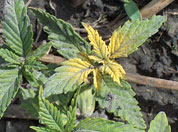 |
The growing point on hemp is found on the apical or apex of the plant. If the growing point should die or be damaged, then the lateral growth will increase and give rise to a bushier plant. The plant will be shorter but the lateral growth will compensate for any yield that would have been lost on the main stalk. This is assuming there is ample time for the lateral growth to develop and mature.
Hail Damage
As with any crop type, hail can have a significant impact on crop production if the injury is severe and at what stage the injury occurs. Some symptoms of hail damage on hemp are leaf shredding, stem bruising, kinking and/or breaking of the various stalks and loss of leaves, tips of stems and possibly fluorescents. |
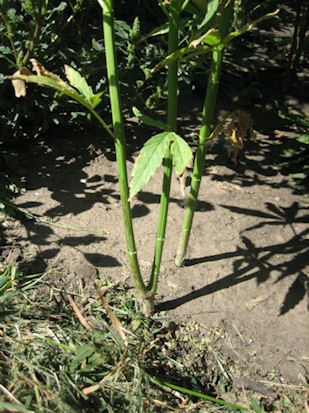 |
Stalk BreakageBecause hemp is day length sensitive, the first part of its development is focused on vegetative growth. In the timeframe from July to early August, hemp can grow 8 to 10 cm a day. The rapid growth causes the straw fibre to be elongated and the lignins are not very rigid. Strong winds and rain during this period can cause the crop to lodge and result in some stalk breakage. The primary purpose of a plant is to reproduce so they are resilient in fulfilling that goal. The damaged plant will try to recover in the same manner as it does with hail damage and similar harvest challenges will occur. |
Harvesting
Hemp production has stringent guidelines that must be followed in order to reduce the spread of hemp seed and plant material. Harvest equipment must be thoroughly cleaned after the harvest operation. Detailed records of hemp sales and grain movement must be kept. The harvested seed must be stored in a locked container or in a facility that has sole access by authorized personnel.
If grain is to be stored into the next calendar year, a new "possession" license from Health Canada is required as of January 1 of the next year.
Grain Harvesting
Hemp grain harvesting is generally performed by straight combining. Hemp seed is prone to sprouting and swathing should only be considered in special situations. Growers in arid locations or that have short varieties may consider swathing as an option. The newer models of combines are better suited to handling the hemp harvest and require minimal modifications. Standing hemp is harvested when the grain sample has a seed moisture range of 10% to 18%. The wetter the sample the more urgent the drying process should begin. Aeration and grain dryers can be used for drying the seed down and the grain requires frequent turning to avoid hot spots developing. Cold air aeration in cold weather will maximize the shelf life of the seed but it will take longer to dry if the percent seed moisture is high. 9- 10% seed moisture is considered appropriate for long term storage. It is important to monitor grain dryer temperatures to ensure the seed and seed oil quality is not compromised. Overheating the seed can cause the seed to turn yellow and discount the oil quality. There tends to be a significant amount of plant material in the harvested sample and this will complicate and prolong the drying process. At the other end of the spectrum, too low of seed moisture could cause the seeds to be prone to cracking during the harvest and handling operations. Grain augers need to be run at full capacity and at a slower speed to minimize seed coat cracking. Seed coat cracking will cause the oil to oxidize and accelerate the rancidity process. Grain processors have strict quality guidelines when purchasing the grain. The storage life of hemp is approximately two to three years before oil quality breaks down. This is a relatively short period of time when compared to other crop types. |
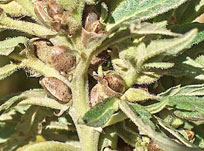 |
As the hemp matures, the bracts surrounding the seed will desiccate and expose the seed for natural dry down. Fall frosts will assist the dry down process and the harvest can generally commence three to five days after a frost. The probability of shattering will increase as the plant dries and high winds can accelerate the incidence of shattering. Bird damage can be a problem as the seeds mature. |
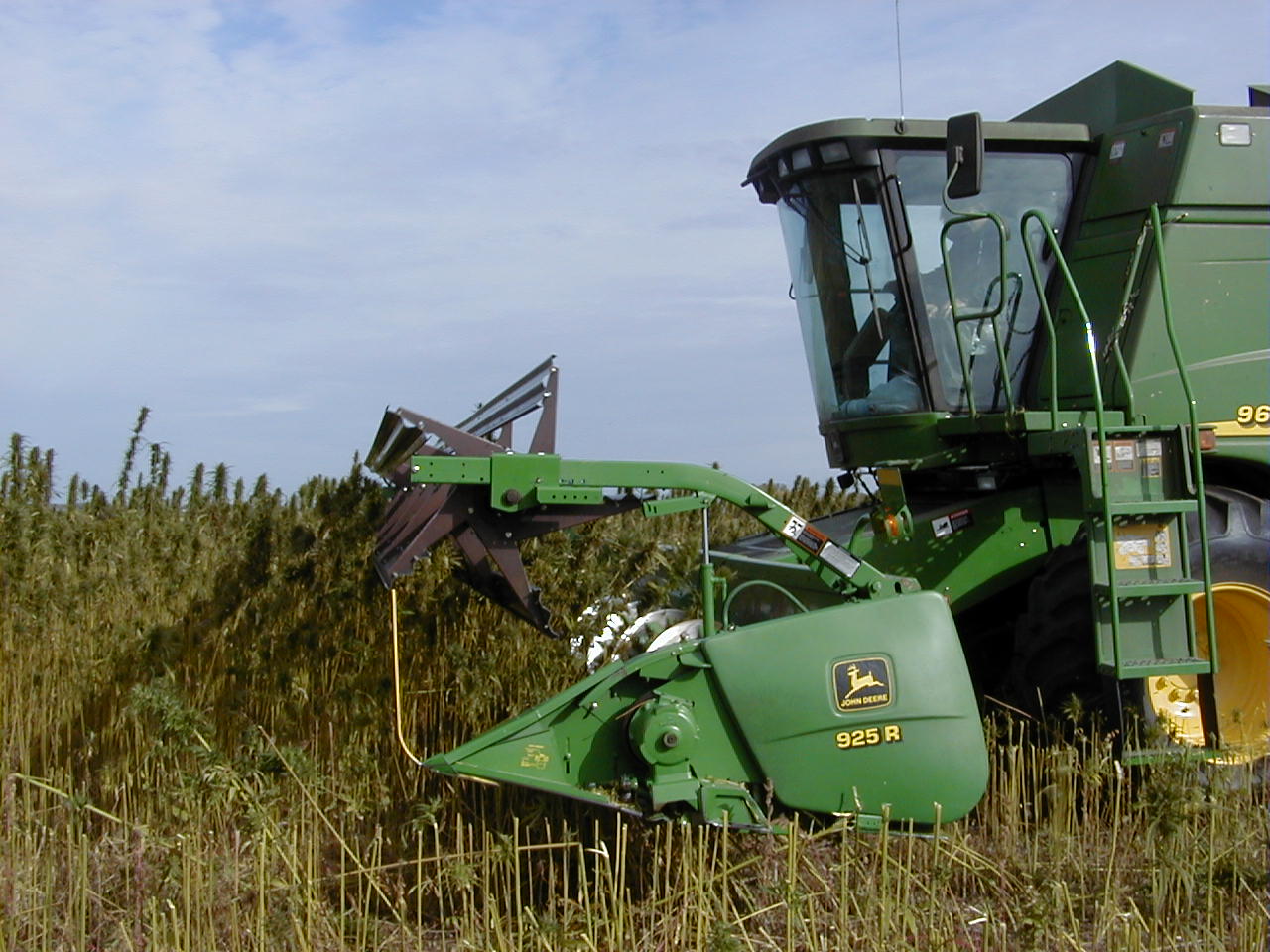 |
The combine should be cleaned out prior to the harvest to ensure no contamination occurs from other crop types. Inadequate clean-out could give rise to higher dockage levels, downgrading of the sample and possible product rejection. Canola setting for rotor speed (550) and wind setting (650 rpm) are recommended as a starting point and adjust accordingly. Adjustments may be required for the different varieties and maturation level of each field. Do not use the chopper as this will complicate the ease of harvest and for fibre end use reasons as well. Adjust the concave to a level that will minimize seed cracking. Some modifications such as covering all shafts, bearings and wires will be required to minimize wrapping of the fiber on combine parts and potential fire hazards. Be watchful of dust collection on motors and other heat sources to avoid fire potentials as well. Operate grain augers full and at a slower speed to reduce cracking and de-hulling of the seed. |
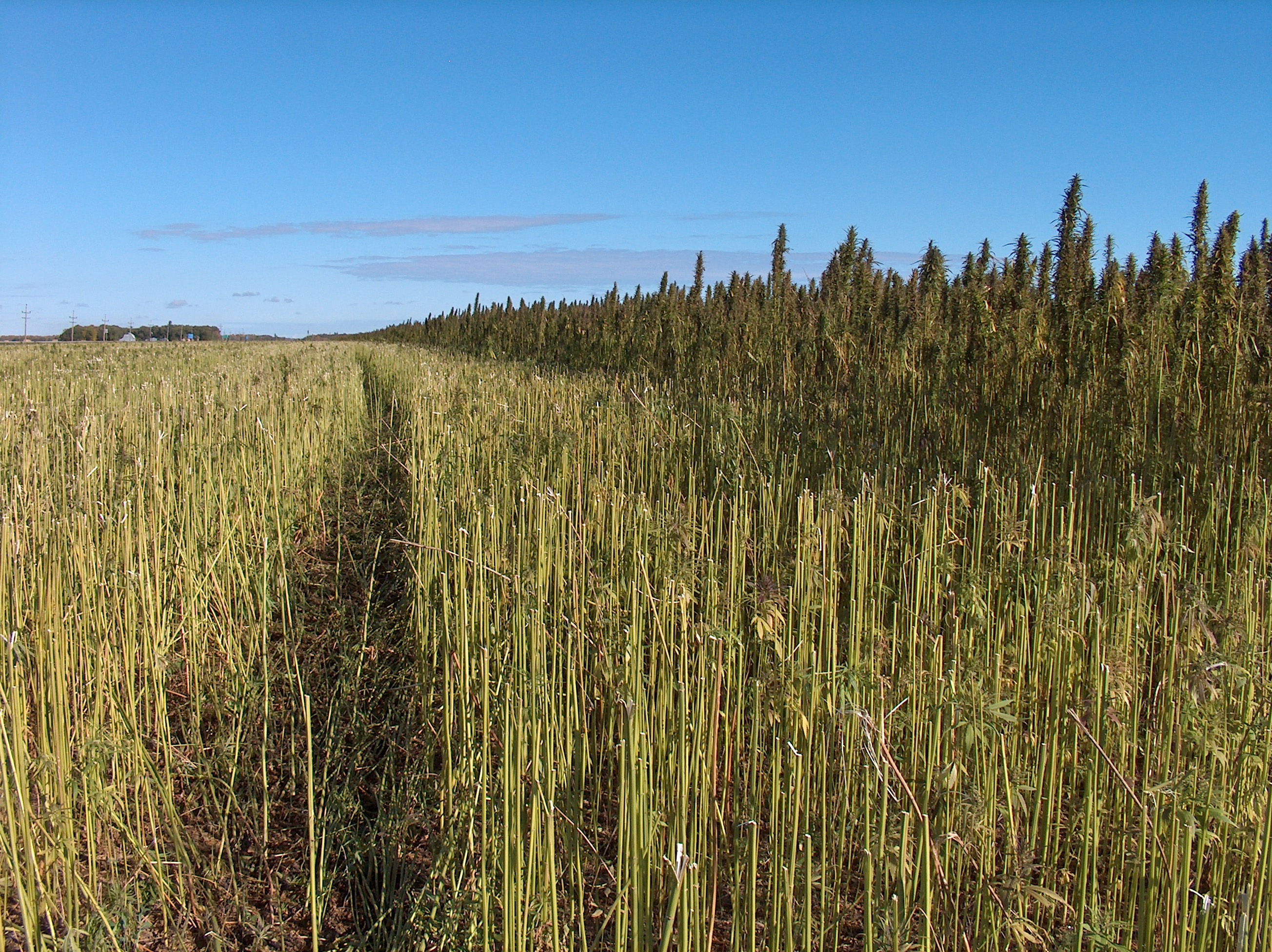 |
The Canadian Grain Commission has not established an official grading and moisture standards for industrial hemp. The industry is accepting 10% as dry for percent seed moisture and safe for storage. Clean bushel weight is generally accepted at 44 pounds per bushel. Conversion tables for use with model 919/3.5 and 393/3.5 Labtronic moisture meters are found on the Canadian Grain Commission website. Hemp can have winter spoilage problems, so close monitoring of the bins is recommended. Target percent seed moisture levels may vary depending on the terms of delivery contracts from the various processors. Please check your contract to ensure all conditions are met. |
 |
Here are some links that may be useful for drying and storing industrial hemp: | |
| |
Grain Cleaning
Since hemp grain is destined for the food market, cleaning standards are very high. Also licensed cleaning facilities are the only ones legally available to clean hemp grain. Hemp tends to have a significant portion of plant material with the seed at harvest time. Efforts are required to ensure all the plant material has been removed. Floral bracts, leaves and flower fragments may be present and they may have small amounts of THC that could taint the oil. In regards to weed seeds, wild buckwheat and volunteer barley are the most difficult to remove.
Another consideration for cleaning is weathered or immature seeds. Mature good quality hemp seeds will have dark markings on them. Frozen or immature seeds have a colorless light brown seed coat. All poor quality seed must be removed through the cleaning process.
Grading
Since CGC has no grading standards, most grain buyers will be vigilant in ensuring the product they buy is acceptable for food standards. It is recommended that producers check their contracts and communicate with processors to ensure their grain will be acceptable.
Peroxide level is a grading factor used by the industry. Peroxide values are a measure of rancidity that may occur in the sample. Industrial hemp processors prefer a grain sample with a peroxide value under a value of 2 meg/kg. Producers can reduce the peroxide levels by minimizing seed injury during harvest, cleaning and handling activities. This can be achieved by harvesting at the higher range of the acceptable percent seed moisture content and slow down the speed of the augers, harvest and cleaning equipment.
Fibre Production
A cross section of a hemp stem shows a green "bark" containing very long, strong fibres called bast fibres. Bast fibres have been used for centuries to make clothing, ropes, twine, paper, etc. The inner white core is called “hurd” and it is a very light and corky short fibre. Hurd fibres have been used in livestock bedding, pulping and building supplies.
A process called retting facilitates the separation of the bast and hurd fibres by breaking down the bond that holds the fibres together. Traditionally, retting is accomplished by letting the stalks lay in the field for several weeks and relying on the weather (dew) to conduct the process. Research is required to determine if the retting process could be improved by turning the swaths during the retting period. Once the retting process has been completed, the straw will be baled and transported to a processing plant or stored. The stalks are mechanically decorticated. Decortication is a process by which the bast fibres are separated from the hurd fibres. The retting process creates efficiencies in the decortication process and provides a high quality, long fibre.
Fibre harvest of hemp is new to the Canadian hemp industry. Processing plants are being constructed and fibre quality specifications will vary depending on the target end use for that particular processing plant.
Grain And Fibre Harvest (Dual Purpose)
For dual purpose production, the grain is harvested and then the straw is cut and left in the field to rett. Target markets for fibre production will dictate if the whole field can be cut or if part of the field needs to remain standing. Depending on the time of grain harvest, the retting process may take all winter and the straw is baled the following spring. Variety selection is important to ensure both grain and fibre markets are achieved.
Alternatives to field retting include enzymatic retting, ultrasonic retting and retting by ensiling, but these approaches are new and require more research. Fibre quality requirements will develop over time as processors determine what fibre quality aspects are needed for the various end use markets. This in turn will dictate the field straw management protocols.
Fibre Only Crop
Production management is different for a fibre only crop production. Variety selection is geared towards high biomass production. The straw is cut when the male plants are in full bloom and shedding pollen. Seed set is not important and should be avoided. When seed set occurs, cellulose and pectin levels accumulate in the stalk and this makes the separation of hurd and bast fibres more difficult. Typically the straw is cut in mid-August and “dew” retts in the field for 4 to 6 weeks, depending on the weather. Cutting is done with mower/conditioners and round balers with minor modifications are used to bale the retted straw. Limited research indicates that fibre yields can be increased by higher seeding rates that result in higher plant populations.
Any one of the fibre markets will be concerned with handling that affects quality. Each processor will have quality specifications that work best for their plant. These include:
- Health Canada regulations require leaves to be removed from the stem, and left on the field. Turning of the swath may be required to remove the leaves.
- Retting – this involves leaving the stalks on the ground for a period of time so they will decorticate easier. This may take several weeks. Rain and or dew speeds up retting.
- Moisture – less than 14% in the bale is desired. In most of the equipment, the dryer it is the easier it will process.
- Colour change – The stalks at cutting should be left to change color from green to white or brown.
- Weeds – other fibre like cereal straw is hard to separate. Most markets will have a low tolerance for weeds.
Yield Expectations
Hemp Grain Yields
Hemp grain yields have been variable over the last number of years. Yield reports have ranged from 100 to 1,200 pounds per acre. It is recommended that new growers budget for a 449-561 kg/ha grain yield (clean, dry basis) while experienced growers can budget for 673 – 898 kg/ha grain yield (clean, dry basis). Refer to the hemp background Table 1 for average Manitoba yields.
Seed Manitoba Guide, is an annual publication that summarizes the yield trials that are conducted in Manitoba each year. Site years tested is the cumulative number of locations over the number of years a variety has been tested. A check variety is included as a reference point to compare new variety performance with. The more site years the more dependable or confident the data is. Varieties are compared as a % of the check variety. Varieties with minimal data should be viewed with caution.
The Manitoba Management Plus Program (MMPP) is a data base that is available from Manitoba farmers that have supplied the Manitoba Agriculture Services Corporation (MASC) with yield and management information. The Manitoba Management Plus Program takes this information and returns it to farmers in user-friendly formats. This information provides farmers with improved access to meaningful production and management information for improving on-farm decision making. Varieties of hemp produced, acreages and yields for various years can be searched using the Variety Yield Data tab found on the left side of the MASC website homepage under Management Plus and Regional Analysis Tools.
Fibre Yields
Hemp for fibre will be harvested as a fibre only crop or a dual grain and fibre crop. In a dual-purpose scenario, stalk yield estimates are 0.75 to 1.5 tonnes/acre.
In crops grown and managed solely for fibre, average yields of 2.5 to 3 tonnes/acre are expected with a range from 1 to 6 tonnes per acre. Moisture content at time of harvest will be about 40% and is required to be dried down to 12 to 14% for baling and storage.
Plant population and variety have a direct effect on grain and fibre yields. Grain yields have a high potential at low plant populations. Fibre yields however require a higher plant population to achieve maximum yield potential and target stem diameter.
Risk Management
Industrial hemp is a relatively new crop with limited research and grower experience. New growers will have to gain experience by growing the crop and obtaining knowledge from experienced growers. The market for hemp products is constantly growing and developing. A potential grower for industrial hemp should research the various available markets for hemp products and determine which production system best suits their farming operation.
Contracted production will reduce some of the risks associated with the marketing of hemp grain and fibre. Contract production will also assist processors in managing supply and demand requirements and minimize the possibility of oversupply. Oversupply could lead to producers storing their product for a longer than expected timeframe and impacting their farm budgets. Longer storage will also impact grain quality and possibly increase the risk of no market availability or marketing the grain into a lower priced end use, such as birdseed.
Manitoba Agricultural Services Corporation (MASC) does mitigate production risk by providing crop insurance for hemp grain production. Full production coverage is available for hemp seeded until June 10. Extended coverage with a reduction of coverage by 20% is available until June 15. Contact MASC for coverage levels. Additional hail insurance is available. Production insurance for fibre only crops is currently not available at this time. Contact your local crop insurance agent for complete details. Additional information is available at the MASC Web Site.
